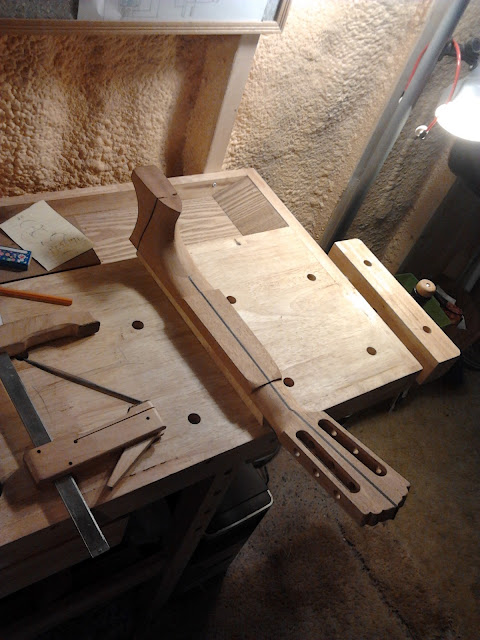I started the day off with a bit of work on my bridge, I believe. Sometimes when I recollect what I did in a day's work, I forget what order I did things in. Anyway, to the bridge... I had to shape the tie block, and give it a bit of a slope, with the high end being the end that was to be nearest the bottom of the guitar, and the low end being that which is closest to the saddle.
 |
| Here's the bridge- you can see the slope I gave to the tie block, on the left. |
 Once all was said and done, I
placed a sheet of wax paper on the bench, and we got some wedges ready
to glue the bone and ebony together. This part was tricky. Ned did
most of the configuring in the gluing process, as he has done it
countless
Once all was said and done, I
placed a sheet of wax paper on the bench, and we got some wedges ready
to glue the bone and ebony together. This part was tricky. Ned did
most of the configuring in the gluing process, as he has done it
countless |
| The small strips of bone |
The ebony and bone bits were left to dry, and more work was done, in the meantime. I got my sides out, and took them upstairs. They were to be soaked in the bathtub for a half an hour, or so, so I drew a bath for them, and placed them in the water. Lunch happened, and then the sides were taken back downstairs, to the shop. Before lunch, Ned had turned the heating peg on, which was used to bend the sides. The sides were about 2mm thick, if I remember correctly, so they have a bit of natural flex to them. Once heat is added, is makes them even more malleable. I did a practice run of bending on a long, thin piece of ebony, to get the gist. I then started bending the sides. I was very cautious at first, as I didn't want to apply too much pressure, which could result in severe damages. I got the hang of how much pressure to add, what motions to make, and how long it takes to heat the wood before the wood sort of "gives." The bending took most of the afternoon, save for a portion that was spent on gluing the ebony and bone pieces onto the bridge's tie block.
 |
| This is the heating peg I used to bend the sides, stained with residue from the Indian rosewood. |
The bone and ebony were taken out of the wedges, where they were glued, and were reduced on the belt sander, to get excess glue off, mostly. I then applied glue, and clamped them into place. While I was doing this, Ned had a client in- I introduced myself, and Ned told him what I was doing, as I continued my work. I used 3 small clamps, placed equidistantly across the length of the tie block. I made the edge closest to the saddle flush, and left the slight overhang at the back of the tie block, as it is easier to access with a file, without having the saddle in the way.
 |
| Here's the bone and ebony, being glued and clamped to the tie block. |
Once the sides were finished, they were placed into a clamping jig, which was in the shape of the guitar. This essentially kept the sides in the shape they were in, while being stored for the week or so that I was to spend away from them, before they get glued. The sides may need a small finishing touch before the gluing process, but I'm not entirely sure.
 |
| Here's one of the sides, bent to shape, and wedged to a form that Ned made. Both sides are now bent, but my camera was too low on battery to take a picture. Next time! |





















